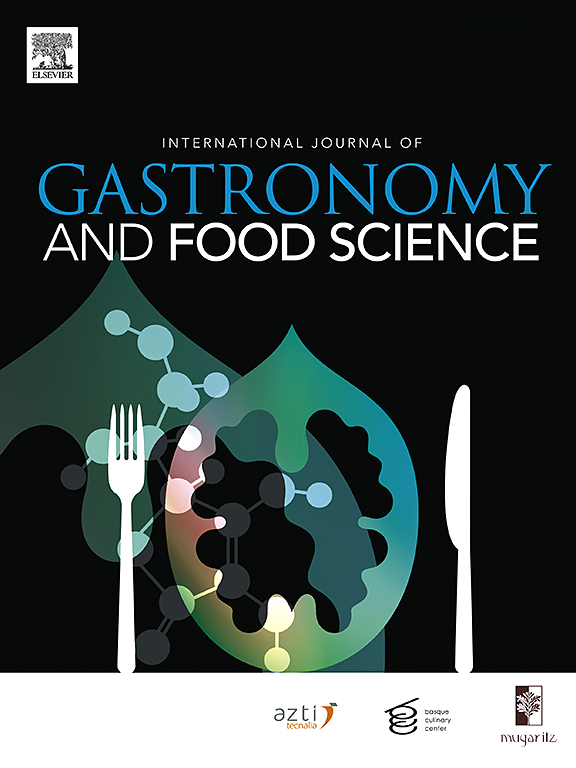食物的形象会误导大脑吗?结合脑电图和情绪识别的神经美食学研究
IF 3.2
2区 农林科学
Q2 FOOD SCIENCE & TECHNOLOGY
International Journal of Gastronomy and Food Science
Pub Date : 2025-01-03
DOI:10.1016/j.ijgfs.2024.101097
引用次数: 0
摘要
这是一项在神经美食学学科中进行的研究,该学科研究食物呈现如何影响我们的大脑,使用传统的感官评估、脑电图和情绪识别技术来探测视觉呈现如何影响味道和情绪。研究人员对21名参与者进行了味觉评分、脑电波和面部表情的测量。结果表明,视觉呈现对味觉和情感体验均有显著影响。因此,喜欢和积极的情绪反应都受到食物视觉外观的显著影响,例如,被评为最具视觉吸引力的食物更有可能被喜欢,并引发更多积极的情绪反应。这些结果强调了视觉美学在提高消费者满意度方面的作用。有人断言,这些发现增加了神经美食学的文献,并有助于理解食物呈现如何影响大脑和行为。该研究为实验神经美食学提供了一种创新和独特的方法,这是文献中的一个重大空白。本文章由计算机程序翻译,如有差异,请以英文原文为准。
Can the image of food mislead the brain? Neurogastronomy research with EEG and emotion recognition
This is a research conducted in the discipline of neurogastronomy, which studies how food presentation affects our brains, using traditional sensory assessment, EEG, and measures of emotion recognition technology to probe how visual presentation affects tastes and emotions. With 21 participants, taste scores, brain waves, and facial expressions were measured during three separate eating experiences of the same meal. The results showed that visual presentation had a significant effect on both taste perception and emotional experiences. Thus, liking and positive emotional response were both significantly influenced by the visual appearance of the food, such that foods rated as most visually appealing were more likely to be liked and evoke more positive emotional responses. These results underscore the role that visual aesthetics have in augmenting consumer satisfaction. It is asserted that the findings add to the body of literature on neurogastronomy and help build understanding on how food presentation impacts brain and behavior. The research offers an innovative and unique methodology regarding experimental neurogastronomy, which is a significant gap in the literature.
求助全文
通过发布文献求助,成功后即可免费获取论文全文。
去求助
来源期刊

International Journal of Gastronomy and Food Science
Social Sciences-Cultural Studies
CiteScore
5.30
自引率
10.50%
发文量
170
审稿时长
45 days
期刊介绍:
International Journal of Gastronomy and Food Science is a peer-reviewed journal that explicitly focuses on the interface of food science and gastronomy. Articles focusing only on food science will not be considered. This journal equally encourages both scientists and chefs to publish original scientific papers, review articles and original culinary works. We seek articles with clear evidence of this interaction. From a scientific perspective, this publication aims to become the home for research from the whole community of food science and gastronomy.
IJGFS explores all aspects related to the growing field of the interaction of gastronomy and food science, in areas such as food chemistry, food technology and culinary techniques, food microbiology, genetics, sensory science, neuroscience, psychology, culinary concepts, culinary trends, and gastronomic experience (all the elements that contribute to the appreciation and enjoyment of the meal. Also relevant is research on science-based educational programs in gastronomy, anthropology, gastronomic history and food sociology. All these areas of knowledge are crucial to gastronomy, as they contribute to a better understanding of this broad term and its practical implications for science and society.
 求助内容:
求助内容: 应助结果提醒方式:
应助结果提醒方式:


